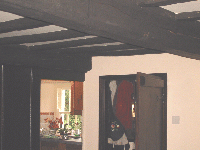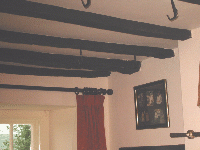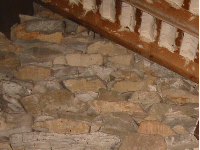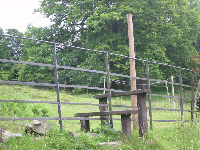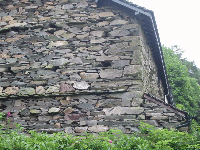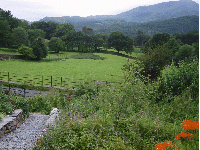| Scroggs House | by © |
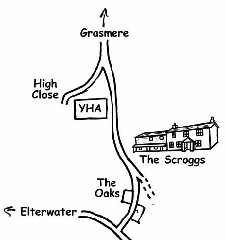 Jonathan Otley 1766-1856, watch and clock repairer, geologist, surveyor, map maker, biologist, studied Grasmere, Keswick and surrounding areas, was born at Scroggs House.
Jonathan Otley 1766-1856, watch and clock repairer, geologist, surveyor, map maker, biologist, studied Grasmere, Keswick and surrounding areas, was born at Scroggs House.
We visited the oldest house known to have been lived in by an ancestor - Nook House, Loughrigg later called Scroggs House in Loughrigg, Ambleside, where Jane Otley was born 1768. The family descent is My first page about Jonathan Otley was at my family site. This page is the result of a visit on Tuesday 8 July, 2003, and on work shared by
| |||||||||||||||||||||||
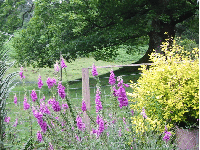
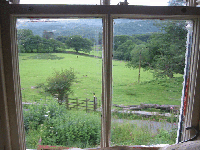 Did Jane and her brothers enjoy the same plants as we saw? The oak tree on the north side, the fields to the south. There are now more trees, as their use as firewood has declined, and oil or electricity are now the prefered polution-free household fuels.
Did Jane and her brothers enjoy the same plants as we saw? The oak tree on the north side, the fields to the south. There are now more trees, as their use as firewood has declined, and oil or electricity are now the prefered polution-free household fuels.
| |||||||||||||||||||||||
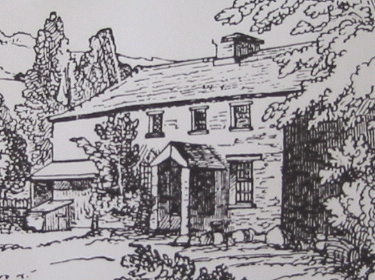 I am assuming this sketch predates the winter photo showing Aunt Mary and neice Jane with her donkey.
I am assuming this sketch predates the winter photo showing Aunt Mary and neice Jane with her donkey.(Also the tree is smaller.) The ground floor originally had doors opening to both south and north. The northern door was sealed when the barn was built. In the recent past the fireplace in the bedroom above the living room was sealed. This sketch does not show the chimney on the eastern end, providing for the kitchen and east-end bedroom fireplaces. | |||||||||||||||||||||||
 Jonathan Otley married the 25th April 1762 to widow Jane Sattherthwaite in the presence of Christopher Grigg (brother of Jane) and Edward Otley (brother of Jonathan). 3 children were born at Nook House, Edward who joined the Army, Jonathan and Jane who wed 1794 to Robert Rigg. Jonathan Otley married the 25th April 1762 to widow Jane Sattherthwaite in the presence of Christopher Grigg (brother of Jane) and Edward Otley (brother of Jonathan). 3 children were born at Nook House, Edward who joined the Army, Jonathan and Jane who wed 1794 to Robert Rigg.Jane had a son John Satterthwaite born c1760 who married and had at least 3 children, Mary c1788, William 1790 and a girl thought to be Jane who married. Her daughter Mary born c1829 married John Wilson born at Langdale in 1828. Mary Satterthwaite, daughter of John, Jane's first child, did not marry. The child with the donkey is probably Jane Wilson. Mary lived at Scroggs till she died in 1869. John & Mary Wilson had been her lodgers since her brother died William died about 1861/2 aged 72. The house passed to Mary Wilson and her family. Their son Arthur Wilson followed his cousin William Atkinson to Australia. ---------------- The 1881 Census reads Dwelling: Scroggs House Census Place: Rydal & Loughrigg, Westmorland, England Source: PRO Ref RG11 Piece 5208 Folio 14 Page 28
Margaret Wilson aged 14 born at Loughrigg is servant of George aged 71 and Margaret Lamb 68, who live in High Close Cottage. | |||||||||||||||||||||||
Around 1840 Scroggs, as Nook House was called, was extended by blocking up the door on the north side, adding a two story barn to the west side, and rendering the walls. The interior was decorated with wall paper, and the floor covered with newspapers and linoleum. At one stage the smoke stained ceiling of the living room was covered so the beams and old oven also vanished from memory, though the hooks remained in view.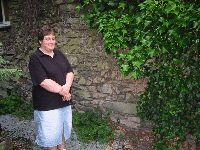
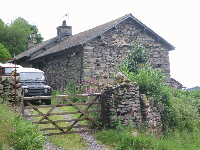 Celeste shows the wooden beam, top of an old doorway probably sealed about 1840 when the barn was built with an upper floor reached from the back near where Celeste is standing, and a lower level opening to the south or front.
Celeste shows the wooden beam, top of an old doorway probably sealed about 1840 when the barn was built with an upper floor reached from the back near where Celeste is standing, and a lower level opening to the south or front.
| |||||||||||||||||||||||
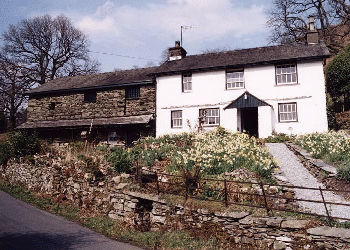 Scroggs cottages as they are known today, are owned by the National Trust, they were part of the High Close Estate that the trust inherited in the 1950's.
Scroggs cottages as they are known today, are owned by the National Trust, they were part of the High Close Estate that the trust inherited in the 1950's.In the year 2002, Scroggs was modernised, and these old beams were uncovered. Two recesses to the right of the fireplace were uncovered, believed to be bread ovens. The third image shows the outside of the west wall as it was before the barn was built, and the exterior rendered. Tim and Celeste have photographed the discoveries, as the floor had a damp-course built, and the improvements of the previous six generations of occupants were removed. Scroggs now has central heating, running water and electricity, all unknown when Jane's grandparents built their family home about 1720. The original staircase, beams and front door have been retained. There are no double-glazed windows - it is a listed building so they are not allowed! The window recess has been remodelled, and relics were found, including an iron spike (like an awl for making holes) and an engraved item that looks a bit like a boot or belt shield. The walls are made of locally gathered stones, carefully knitted together. | |||||||||||||||||||||||
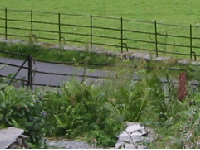 In this year 2003, land usage has changed, and the area is now part of the walking path networks. So the fence, to the north of the house, is protected by this style. The end of the barn attracts attention, showing the stone-wall skills involved.
In this year 2003, land usage has changed, and the area is now part of the walking path networks. So the fence, to the north of the house, is protected by this style. The end of the barn attracts attention, showing the stone-wall skills involved.The third view looking south, of the front footpath and rolling grasslands, shows some of the charm that attracts so many visitors. The iron fences are 'heritage', being installed by the former owner. This closeup, of the turn in the footpath, shows details. | |||||||||||||||||||||||
| by © 4 x great neice |
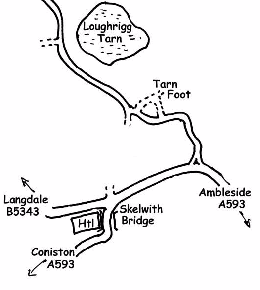 Jane Rigg 1797 wed 1830 to William Atkinson
Jane Rigg 1797 wed 1830 to William Atkinson